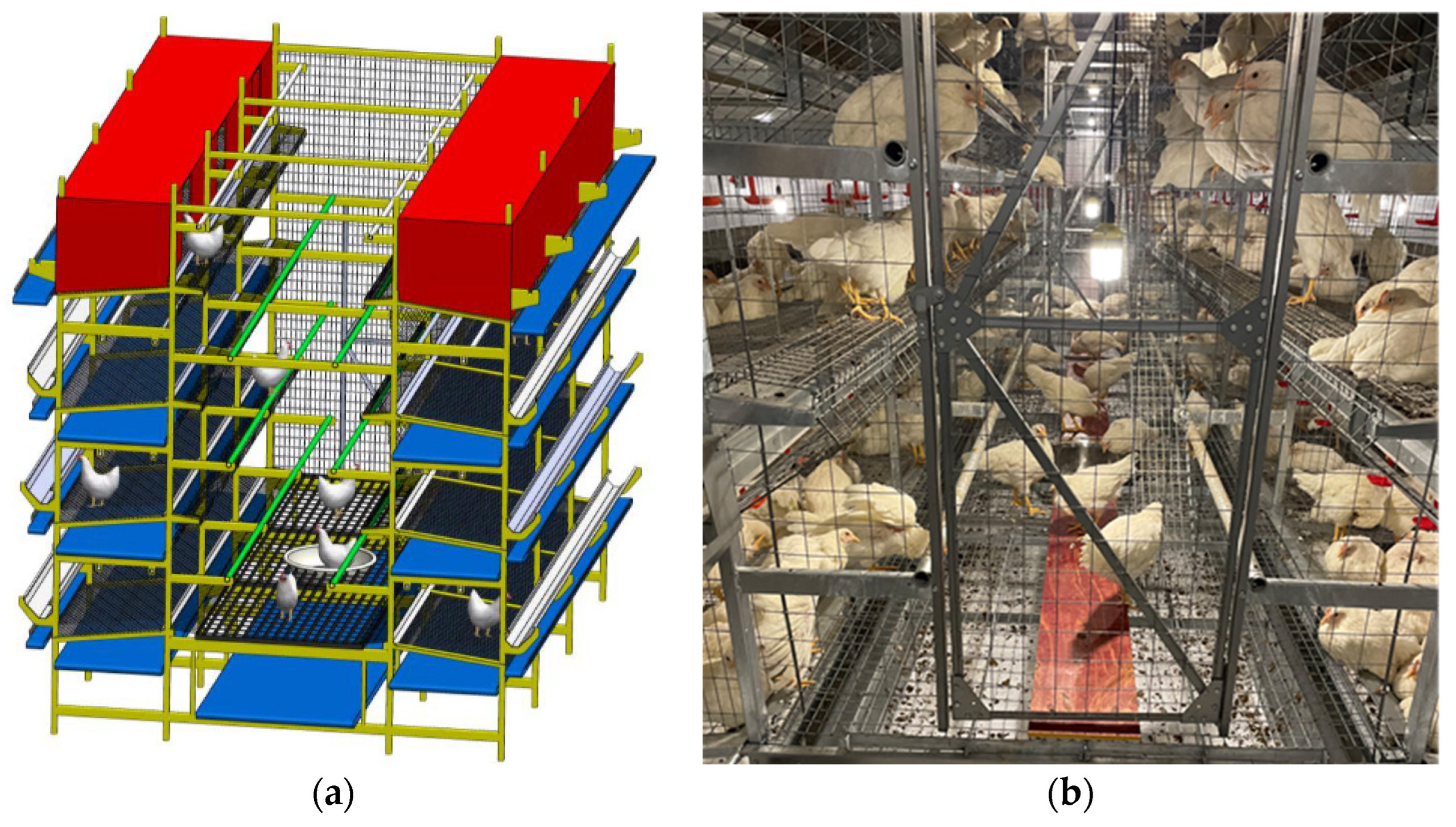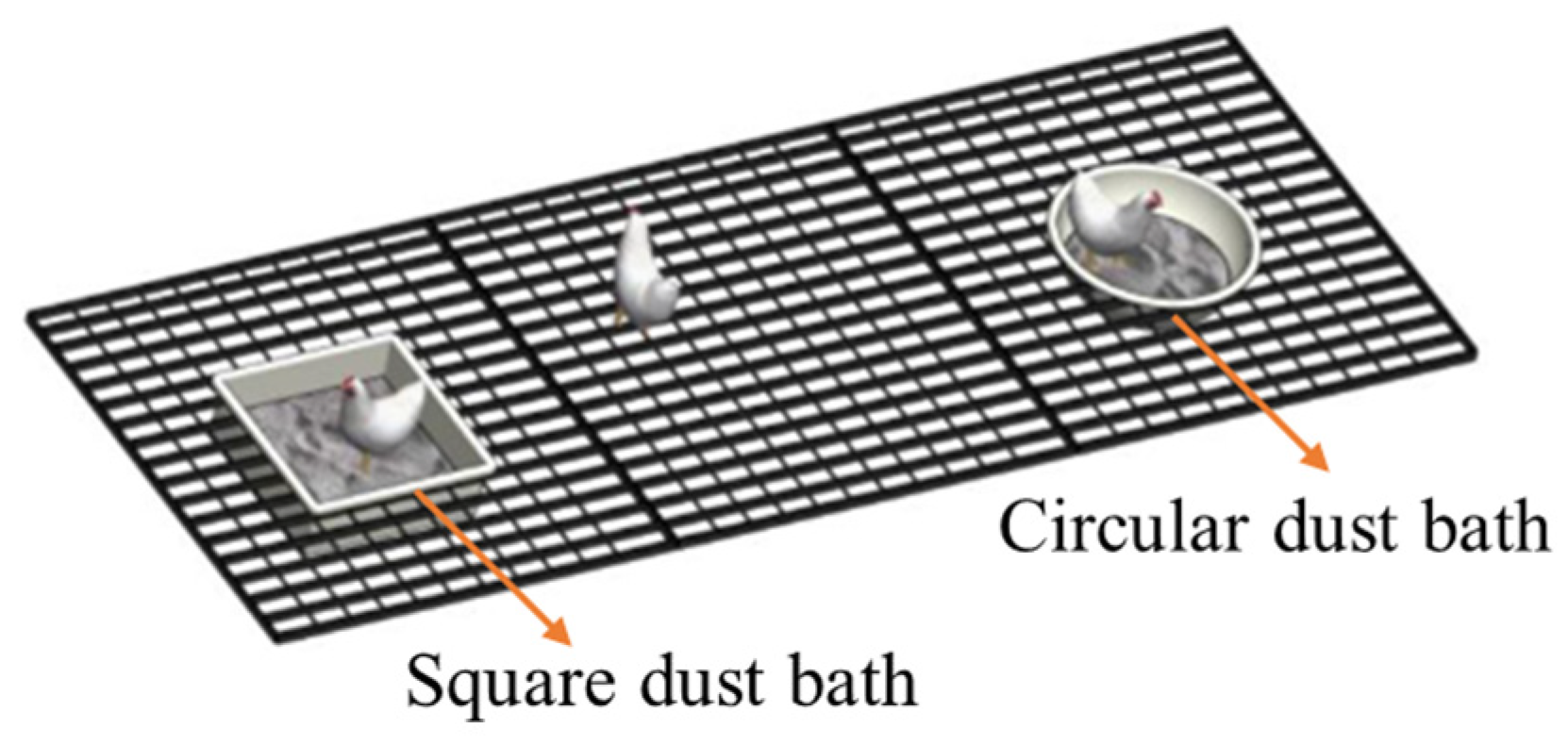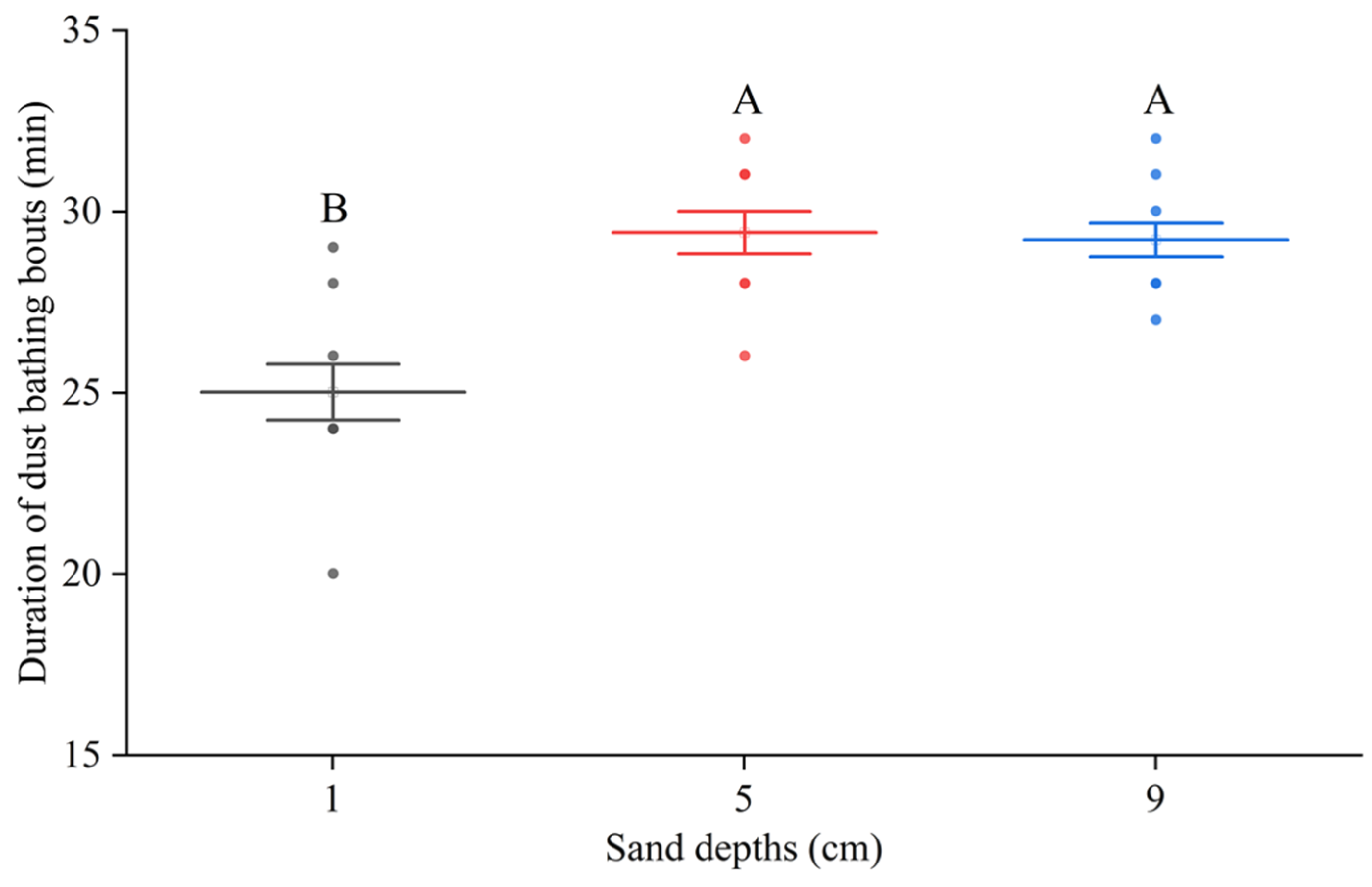Effects of Dust Bath Design on Hen Behavior in New Aviary Systems in China
Abstract
Simple Summary
Abstract
1. Introduction
2. Materials and Methods
2.1. Hens and Housing System
2.2. Experimental Design
2.2.1. Dust Bath Area
2.2.2. Dust Bath Shape
2.2.3. Substrate Depth
2.3. Statistical Analysis
3. Results
3.1. Effects of Dust Bath Area on Dustbathing Behavior
3.2. Effects of Dust Bath Shape on Dustbathing Behavior
3.3. Effects of Substrate Depth on Dust Bathing Behavior
4. Discussion
5. Conclusions
Author Contributions
Funding
Institutional Review Board Statement
Informed Consent Statement
Data Availability Statement
Acknowledgments
Conflicts of Interest
References
- Campbell, D.L.M.; de Haas, E.N.; Lee, C. A review of environmental enrichment for laying hens during rearing in relation to their behavioral and physiological development. Poult. Sci. 2019, 98, 9–28. [Google Scholar] [CrossRef]
- Regmi, P.; Deland, T.S.; Steibel, J.P.; Robison, C.I.; Haut, R.C.; Orth, M.W.; Karcher, D.M. Effect of rearing environment on bone growth of pullets. Poult. Sci. 2015, 94, 502–511. [Google Scholar] [CrossRef]
- Tactacan, G.B.; Guenter, W.; Lewis, N.J.; Rodriguez-Lecompte, J.C.; House, J.D. Performance and welfare of laying hens in conventional and enriched cages. Poult. Sci. 2009, 88, 698–707. [Google Scholar] [CrossRef]
- Li, Z.Y.; Wang, C.Y.; Li, B.M.; Shi, Z.X.; Zheng, W.C.; Teng, G.H. Concentration and size distribution of particulate matter in a new aviary system for laying hens in China. J. Air Waste Manag. Assoc. 2020, 70, 379–392. [Google Scholar] [CrossRef]
- Campbell, D.L.M.; Ali, A.B.A.; Karcher, D.M.; Siegford, J.M. Laying hens in aviaries with different litter substrates: Behavior across the flock cycle and feather lipid content. Poult. Sci. 2017, 96, 3824–3835. [Google Scholar] [CrossRef]
- Banhazi, T.M.; Seedorf, J.; Laffrique, M.; Rutley, D.L. Identification of the risk factors for high airborne particle concentrations in broiler buildings using statistical modelling. Biosyst. Eng. 2008, 101, 100–110. [Google Scholar] [CrossRef]
- Le Bouquin, S.; Huneau-Salauen, A.; Huonnic, D.; Balaine, L.; Martin, S.; Michel, V. Aerial dust concentration in cage-housed, floor-housed, and aviary facilities for laying hens. Poult. Sci. 2013, 92, 2827–2833. [Google Scholar] [CrossRef]
- Mazaheri, A.; Lierz, M.; Hafez, H.M. Investigations on the pathogenicity of Erysipelothrix rhusiopathiae in laying hens. Avian Dis. 2005, 49, 574–576. [Google Scholar] [CrossRef]
- Shepherd, T.A.; Zhao, Y.; Li, H.; Stinn, J.P.; Hayes, M.D.; Xin, H. Environmental assessment of three egg production systems—Part II-ammonia, greenhouse gas, and particulate matter emissions. Poult. Sci. 2015, 94, 534–543. [Google Scholar] [CrossRef]
- Zhao, Y.; Shepherd, T.A.; Li, H.; Xin, H. Environmental assessment of three egg production systems—Part I: Monitoring system and indoor air quality. Poult. Sci. 2015, 94, 518–533. [Google Scholar] [CrossRef]
- Martin, C.D.; Mullens, B.A. Housing and dustbathing effects on northern fowl mites (Ornithonyssus sylviarum) and chicken body lice (Menacanthus stramineus) on hens. Med. Vet. Entomol. 2012, 26, 323–333. [Google Scholar] [CrossRef]
- Vanliere, D. Dustbathing as related to proximal and distal feather lipids in laying hens. Behav. Process. 1992, 26, 177–188. [Google Scholar] [CrossRef]
- Olsson, I.A.S.; Keeling, L.J. Why in earth? Dustbathing behaviour in jungle and domestic fowl reviewed from a tinbergian and animal welfare perspective. Appl. Anim. Behav. Sci. 2005, 93, 259–282. [Google Scholar] [CrossRef]
- Alvino, G.M.; Tucker, C.B.; Archer, G.S.; Mench, J.A. Astroturf as a dustbathing substrate for laying hens. Appl. Anim. Behav. Sci. 2013, 146, 88–95. [Google Scholar] [CrossRef]
- Pokharel, B.B.; Boecker, I.; Kwon, I.Y.; Jeyachanthiran, L.; McBride, P.; Harlander-Matauschek, A. How does the presence of excreta affect the behavior of laying hens on scratch pads? Poult. Sci. 2018, 97, 743–748. [Google Scholar] [CrossRef]
- Guinebretière, M.; Michel, V.; Arnould, C. Dustbathing, pecking and scratching behaviours of laying hens in furnished cages are enhanced by the presence of rubber mats and litter distribution. Appl. Anim. Behav. Sci. 2015, 171, 128–137. [Google Scholar] [CrossRef]
- Lee, H.-W.; Louton, H.; Schwarzer, A.; Rauch, E.; Probst, A.; Shao, S.; Schmidt, P.; Erhard, M.H.; Bergmann, S. Effects of multiple daily litter applications on the dust bathing behaviour of laying hens kept in an enriched cage system. Appl. Anim. Behav. Sci. 2016, 178, 51–59. [Google Scholar] [CrossRef]
- Scholz, B.; Kjaer, J.B.; Urselmans, S.; Schrader, L. Litter lipid content affects dustbathing behavior in laying hens. Poult. Sci. 2011, 90, 2433–2439. [Google Scholar] [CrossRef]
- Sandilands, V.; Baker, L.; Donbavand, J.; Brocklehurst, S. Effects of different scratch mat designs on hen behaviour and eggs laid in enriched cages. Animals 2021, 11, 1544. [Google Scholar] [CrossRef]
- Zhang, Q. Study on Sand Bath Behavior of Laying Hens and Its Facilities in Large Cage Aviary Unit System. Master’s Thesis, China Agricultural University, Beijing, China, 2023. [Google Scholar]
- Nørgaard-Nielsen, G. Dustbathing and feather pecking in domestic chickens reared with and without access to sand. Appl. Anim. Behav. Sci. 1997, 52, 99–108. [Google Scholar] [CrossRef]
- Moesta, A.; Knierim, U.; Briese, A.; Hartung, J. The effect of litter condition and depth on the suitability of wood shavings for dustbathing behaviour. Appl. Anim. Behav. Sci. 2008, 115, 160–170. [Google Scholar] [CrossRef]
- Knierim, U.; Schrader, L.; Steiger, A. Alternative Legehennenhaltung in Der Praxis: Erfahrungen, Probleme, Lösungsansätze; FAL: Braunschweig, Germany, 2006. [Google Scholar]
- Louton, H.; Bergmann, S.; Reese, S.; Erhard, M.H.; Rauch, E. Dust-bathing behavior of laying hens in enriched colony housing systems and an aviary system. Poult. Sci. 2016, 95, 1482–1491. [Google Scholar] [CrossRef]
- van Liere, D.W. The significance of fowls’ bathing in dust. Anim. Welf. 1992, 1, 187–202. [Google Scholar] [CrossRef]
- Roll, V.F.B.; Levrino, G.A.M.; Briz, R.C. Rearing system and behavioural adaptation of laying hens to furnished cages. Cienc. Rural 2008, 38, 1997–2003. [Google Scholar] [CrossRef]
- Wall, H.; Tauson, R.; Elwinger, K. Effects of litter substrate and genotype on layers’ use of litter, exterior appearance, and heterophil:lymphocyte ratios in furnished cages. Poult. Sci. 2008, 87, 2458–2465. [Google Scholar] [CrossRef]
- Sanotra, G.S.; Vestergaard, K.S.; Agger, J.F.; Lawson, L.G. The relative preferences for feathers, straw, wood-shavings and sand for dustbathing, pecking and scratching in domestic chicks. Appl. Anim. Behav. Sci. 1995, 43, 263–277. [Google Scholar] [CrossRef]
- Grebey, T.C.; Ali, A.B.A.; Swanson, J.C.; Widowski, T.M.; Siegford, J.M. Dust bathing in laying hens: Strain, proximity to, and number of conspecifics matter. Poult. Sci. 2020, 99, 4103–4112. [Google Scholar] [CrossRef]
- Li, M.X. The Effect of Cement Mortar Ground Covered with Thin Sand on the Physical Condition and Behavior of Laying Hens. Master’s Thesis, China Agricultural University, Beijing, China, 2017. [Google Scholar]
- Vestergaard, K. Dust-bathing in the domestic fowl—Diurnal rhythm and dust deprivation. Appl. Anim. Ethol. 1982, 8, 487–495. [Google Scholar] [CrossRef]
- van Liere, D.W. Function and Organization of Dustbathing in Laying Hens; Wageningen Landbouwuniversiteit: Wageningen, The Netherlands, 1991. [Google Scholar]
- Campbell, D.L.M.; Makagon, M.M.; Swanson, J.C.; Siegford, J.M. Litter use by laying hens in a commercial aviary: Dust bathing and piling. Poult. Sci. 2016, 95, 164–175. [Google Scholar] [CrossRef]
- Olsson, I.A.S.; Duncan, I.J.H.; Keeling, L.J.; Widowski, T.M. How important is social facilitation for dustbathing in laying hens? Appl. Anim. Behav. Sci. 2002, 79, 285–297. [Google Scholar] [CrossRef]
- Carol Petherick, J.; Seawright, E.; Waddington, D.; Duncan, I.J.H.; Murphy, L.B. The role of perception in the causation of dustbathing behaviour in domestic fowl. Anim. Behav. 1995, 49, 1521–1530. [Google Scholar] [CrossRef]
- Yin, P.; Tong, Q.; Li, B.M.; Zheng, W.C.; Wang, Y.; Peng, H.Q.; Xue, X.L.; Wei, S.Q. Spatial distribution, movement, body damage, and feather condition of laying hens in a multi-tier system. Poult. Sci. 2024, 103, 103202. [Google Scholar] [CrossRef]
- Petherick, J.C.; Duncan, I.J.H. Behaviour of young domestic fowl directed towards different substrates. Br. Poult. Sci. 1989, 30, 229–238. [Google Scholar] [CrossRef]





| Number of Hens Dustbathing Simultaneously | Proportion (%) | |
|---|---|---|
| 1 Dust Bath | 2 Dust Baths | |
| 2 | 74.17 ± 1.84 A | 55.68 ± 9.83 A |
| 3 | 18.72 ± 0.75 B | 26.58 ± 5.57 B |
| 4 | 4.5 ± 1.5 C | 6.9 ± 3.67 C |
| 5 | 2.61 ± 1.56 C | 3.33 ± 2.49 C |
| 6 | - | 2.8 ± 1.5 C |
| 7 | - | 2.49 ± 1.42 C |
| 8 | - | 2.26 ± 1.51 C |
| Maximum number | 5 | 8 |
| Indicators | Circular Dust Bath | Square Dust Bath |
|---|---|---|
| Duration of a leg stretch action (s) | 0.6 ± 0.1 A | 0.9 ± 0.0 B |
| Continuity score of side rubbing bouts | 1.0 ± 0.0 A | 0.4 ± 0.2 B |
| Number of side rubbing bouts | 2.2 ± 0.2 a | 1.5 ± 0.2 b |
| Tossing behavior frequency (times/min) | 3.4 ± 0.3 b | 4.4 ± 0.3 a |
| Substrate Depth (cm) | Duration of a Leg Stretch Action (s) | Tossing Behavior Frequency (times/min) |
|---|---|---|
| 1 | 0.5 ± 0.0 B | 4.4 ± 0.2 A |
| 5 | 0.6 ± 0.0 B | 3.3 ± 0.2 B |
| 9 | 1.0 ± 0.0 A | 4.5 ± 0.2 A |
Disclaimer/Publisher’s Note: The statements, opinions and data contained in all publications are solely those of the individual author(s) and contributor(s) and not of MDPI and/or the editor(s). MDPI and/or the editor(s) disclaim responsibility for any injury to people or property resulting from any ideas, methods, instructions or products referred to in the content. |
© 2025 by the authors. Licensee MDPI, Basel, Switzerland. This article is an open access article distributed under the terms and conditions of the Creative Commons Attribution (CC BY) license (https://creativecommons.org/licenses/by/4.0/).
Share and Cite
Zhang, Z.; Zhang, Q.; Xu, J.; Li, B.; Zheng, W.; Wang, Y. Effects of Dust Bath Design on Hen Behavior in New Aviary Systems in China. Animals 2025, 15, 2946. https://doi.org/10.3390/ani15202946
Zhang Z, Zhang Q, Xu J, Li B, Zheng W, Wang Y. Effects of Dust Bath Design on Hen Behavior in New Aviary Systems in China. Animals. 2025; 15(20):2946. https://doi.org/10.3390/ani15202946
Chicago/Turabian StyleZhang, Zhihao, Qian Zhang, Jianying Xu, Baoming Li, Weichao Zheng, and Yang Wang. 2025. "Effects of Dust Bath Design on Hen Behavior in New Aviary Systems in China" Animals 15, no. 20: 2946. https://doi.org/10.3390/ani15202946
APA StyleZhang, Z., Zhang, Q., Xu, J., Li, B., Zheng, W., & Wang, Y. (2025). Effects of Dust Bath Design on Hen Behavior in New Aviary Systems in China. Animals, 15(20), 2946. https://doi.org/10.3390/ani15202946







